
What is the Difference Between Precious and Common Opal?
 If you know opal for its rainbow-like iridescence, you may be confused to see other opal stones not displaying this phenomenon. It’s important to know that there are two main types of opal: precious and common. Precious opal’s ability to show play-of-color is the key difference between precious opal and common opal.
If you know opal for its rainbow-like iridescence, you may be confused to see other opal stones not displaying this phenomenon. It’s important to know that there are two main types of opal: precious and common. Precious opal’s ability to show play-of-color is the key difference between precious opal and common opal.
Opals are often called chameleon gems because they come in so many shapes, sizes, and colors. Popular types of opals include crystal opal, black opal, and water opal. Many lesser-known species exist as well, like the volcanic opal called Tintenbar.
The average gem-lover may know opal as the October birthstone or Libra zodiac stone. Maybe you’ve heard the superstitions about opals being “bad luck?” Well, superstition is exactly what it is. Opals are full of positive energy and have been around for centuries.
In the modern era, scientists and gemologists have been able to reveal many of opal’s long-held secrets.
One key discovery is the difference between precious opal and common opal.
Today, we’ll break down everything you need to know about the two key types of opal. Along the way, we’ll answer all your pressing questions, like how to identify common opal and which opal is best.
First up, let’s discuss common opals!
 Dendritic opal (pictured above) is a type of common opal that doesn't show any fire or play of color.
Dendritic opal (pictured above) is a type of common opal that doesn't show any fire or play of color.
What Are Common Opals?
Common opals, or potch, are the more abundant of the two types of opals. The easiest way to describe this type of opal is to say what it’s not. Common opals are any opals that do not show play-of-color. But what is play-of-color?
Play-of-color is an optical phenomenon specific to precious opals. The stone’s surface displays flashes of various colors that can change based on the viewing angle.
Since common opals don’t show play-of-color, they’re not as instantly recognizable as precious opals. If you’re wondering how to identify common opal, the easiest method is a scratch test.
Common opals often look similar to other stones like jasper. However, common opal is significantly less durable than most gemstones, ranking at a 5.5-6 on the Mohs scale of mineral hardness. That means you can scratch this gem’s surface with a basic pocket knife.
Another identification method is by weight. For example, if you have an opal and a quartz stone of roughly the same size, the opal will be noticeably lighter.
If a common opal is fractured or broken, the inside will have the same shiny luster as the rest of the stone. Similar stones like agate have a more waxy internal luster when broken.
Common opals may not show play-of-color, but they still form in gorgeous hues. Pastel varieties include soft pinks, greens, yellows, and blues. White opal is the most abundant color, while black opal and red opal are the rarest.
Feeling confident in your identification skills? Great!
The next stop on our journey through the difference between precious opal and common opal is all about the iridescent precious opal.
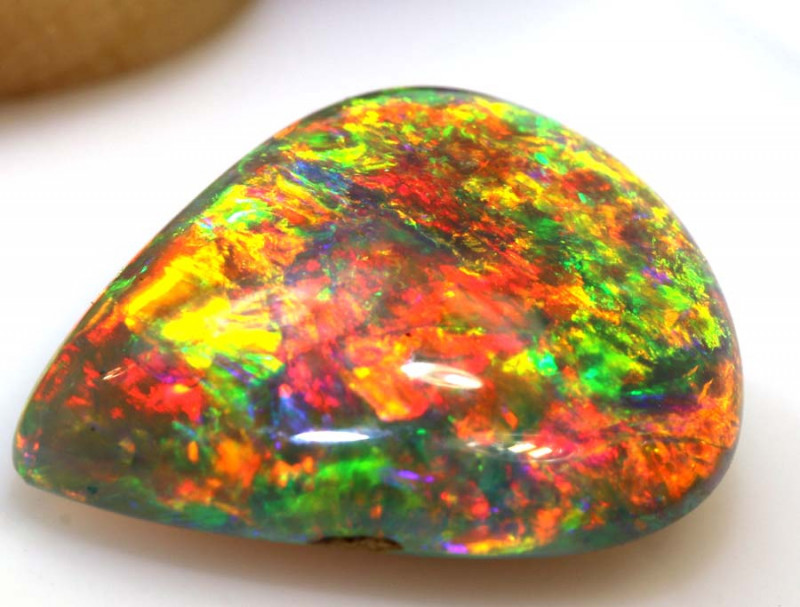 A striking precious opal crystal from Lightning Ridge (picture above) exhibiting vivid play of color.
A striking precious opal crystal from Lightning Ridge (picture above) exhibiting vivid play of color.
What Is A Precious Opal?
As we’ve discussed, precious opal is distinguished by its ability to show play-of-color. But how does it work? What causes play-of-color?
The reason for the gem’s play-of-color has been theorized by various scientists since the 18th century. The true cause wasn’t discovered until 1966 when two Australian scientists, John V. Sanders and Peter J. Darragh, figured it out.
Based on Sanders and Darragh’s research, play-of-color occurs because of precious opal’s internal structure.
All opals are composed of silica and water. At a microscopic level, the silica is in spherical shapes. With common opals, the spheres are disorganized and uneven. Precious opal’s silica spheres are all the same size and arranged in a neat grid.
Wayne Sedawie here at Opal Auctions attributes the play-of-color to the “ѕіlіса ѕрhеrеѕ dissecting light on its раѕѕаgе through the gеmѕtоnе and turning it into all thе соlоurѕ оf thе rаinbоw.” Most precious opals won’t show every color of the rainbow, but they will show at least 3 colors.
There’s more to this stone than its attractive iridescence, however. Precious opal’s body tone, which comes from impurities, is equally important.
When opal forms, whether common or precious, other chemicals can get caught in the mix. When these elements get stuck inside opal’s silica spheres, they give the stone a new background color or body tone.
Precious opals can have a few different body tones, including white, black, yellow, and blue, to name a few.
If you’re not sure what your opal’s body tone is, we’ve got you covered! Read our “Opal Body Tone Guide” to learn more.
Alright, we’re all caught up on the difference between precious opal and common opal. But did you know precious opal and common opal each have different varieties?
Types of Common Opals
Common opals come in so many colors and varieties, listing every single one would be taxing to read. Instead, we’ve narrowed down the key types you should know.
Agate Opal
Agate opal is a variety with a banded color pattern on its surface. It can form around fossils or in rock veins.
Despite the name, agate opal does not contain agate. The moniker comes from this variety’s resemblance to agate’s signature color banding.

Moss Opal
Moss opal is found in the Ogallala Formation and contains inclusions of various iron minerals. The stone’s inclusions resemble moss’s small collection of branching tendrils.
Some refer to moss opal as “dendritic opal” because the inclusions could be called dendrites. The most common iron mineral present in moss opal is manganese oxide.

Hyalite
Hyalite is special because of its clarity. While most common opals have an opaque luster, hyalite is translucent. In most cases, translucent opals are precious opals. The feature that differentiates hyalite opal from other types of common opal is its unique bulbous clusters called "globules."
Hyalite opal is much less hydrated than other forms of opal, with around 3-4% water content. The colorless variety forms in cavities of volcanic rock or in ore deposits coating secondary minerals.

Peruvian Opal
Peruvian opal refers to a category rather than a specific stone. Peru is known for producing gorgeous pastel opals. The most popular of these soft shades are pink, blue, and green.
Most Peruvian opals come from one of two provinces: Ica or Caraveli. The Ica province specializes in pink opals, while the Caraveli province produces a blue variety nicknamed “Andean opal.”
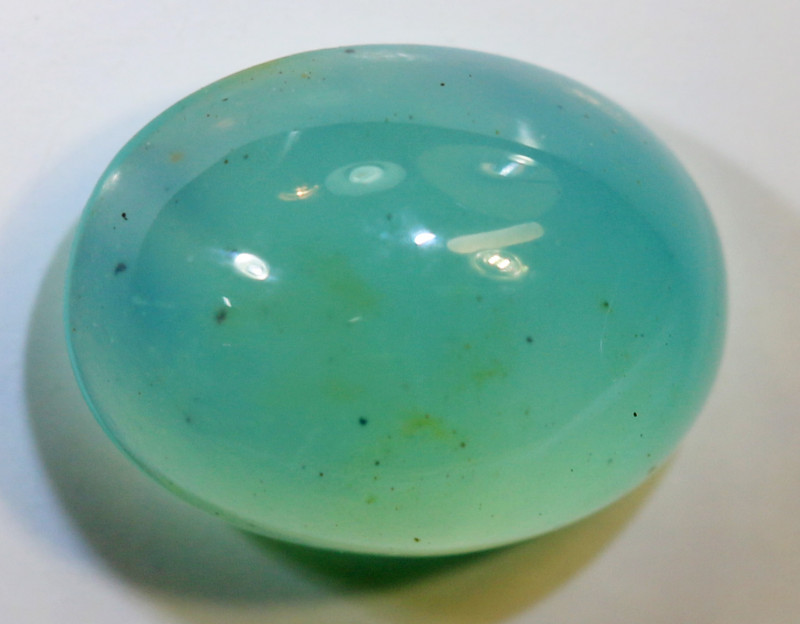
Fluorescent Common Opals
Fluorescent opal is another fascinating category. Fluorescent opals can show glowing fluorescence under UV light. The stone usually glows in electric green color.
The presence of uranium is what causes these opals’ fluorescence. Most of the gems with strong fluorescence come from Virgin Valley, Nevada.
Of course, precious opal has its own distinct varieties as well. Let’s take a closer look!

Types of Precious Opals
As you might’ve guessed, every variety in this list shows play-of-color. However, some opals can have a common opal version and a precious opal version.
For instance, water opal sometimes shows play-of-color and sometimes doesn’t. Black opal has a common form and a precious form.
That being said, plenty of opal varieties always show play-of-color and bring their own unique traits to the table.
Boulder Opal
Remember how not all precious opals flash every color of the rainbow? Well, boulder opal is the exception. Boulder opal’s color play flashes all seven colors of the rainbow!
Boulder opal comes from Queensland, Australia. This variety is often combined with ironstone in a matrix or layered pattern.

Precious Black Opal
As the name suggests, precious black opal has a black body tone. The stone has weak opalescence if any at all, but stunning colors.
The black base of precious black opal allows the flashes of color play to shine even more brightly. Lightning Ridge, Australia, is the primary source of this exclusive variety.
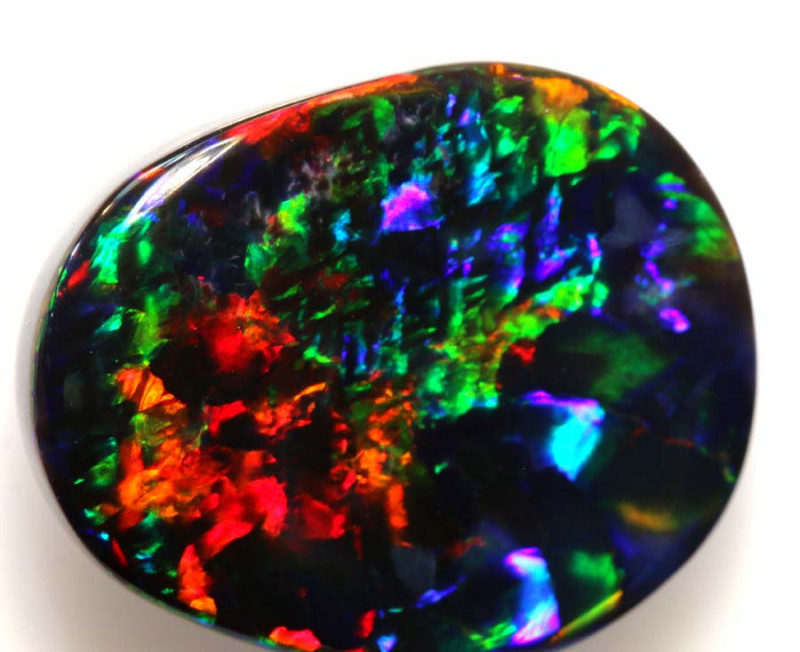
Crystal Opal
Crystal opal’s name is based on its translucence, as some light can pass through this variety. In fact, crystal opal’s translucence creates play-of-color on the surface of the stone and inside it.
If you shine a light through the gem, it looks like jelly, which has led some to call it “jelly opal.” The base tones are numerous, with blue, yellow, white, and even black crystal hues.
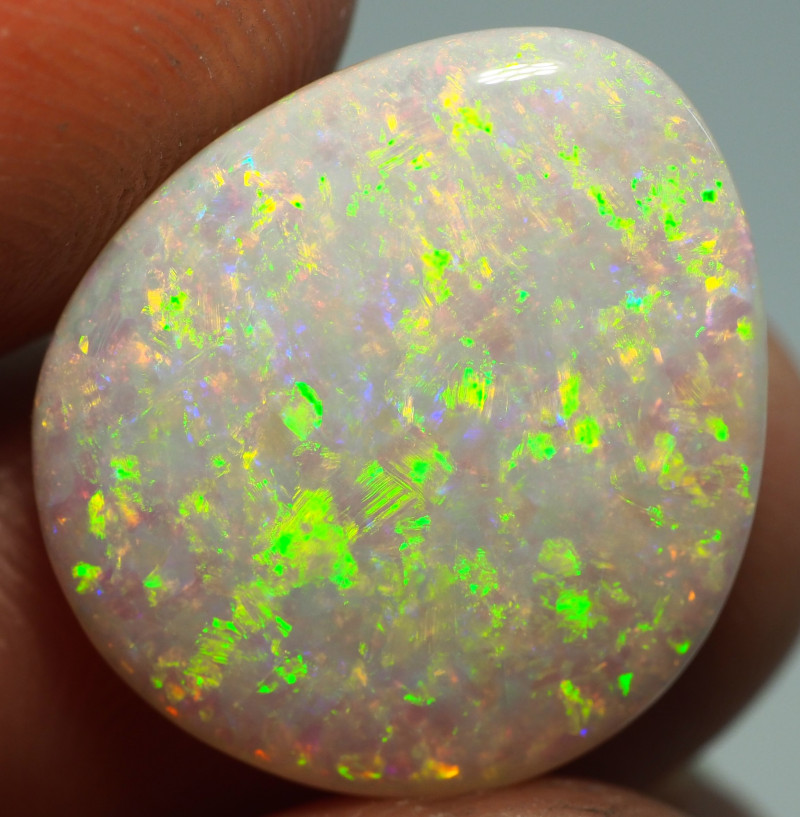
Matrix Opal
Matrix opal, sometimes referred to as “Type 3 opal,” covers a group of opals with unique color play. Unlike other opals which show the play of color across the surface of the stone, matrix opal’s play-of-color occurs throughout the entire stone.
Mined all over the world, matrix opal is found combined with host rock. Common host rocks include ironstone, limestone, sandstone, rhyolite, and basalt.
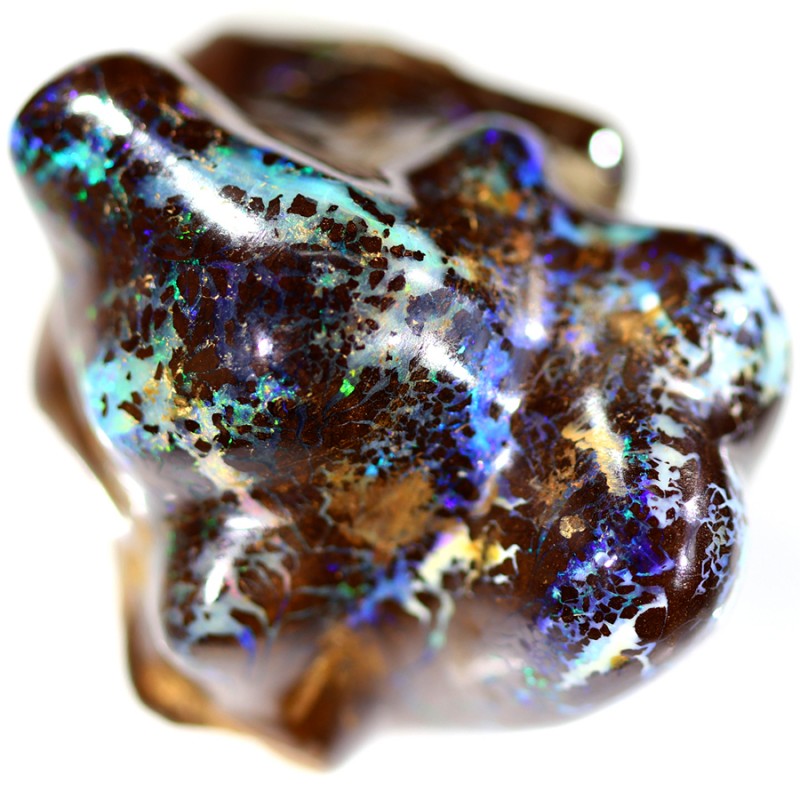
Patterned Precious Opals
Play-of-color can show up in distinct opal patterns. Some patterns go by specific names and become that opal variety’s nickname.
Here are the most notable patterns:
Pinfire. Pinfire, or pinpoint, describes a color play pattern in small, concentrated areas throughout the opal. The pattern resembles a peppering of colors.

Flame. Flame opal’s play-of-color is an explosive display of red bands and streaks that look like flames burning through the surface of the stone. The flames come in when you turn the stone in your hand, as the color play flashes and flickers like candlelight.

Harlequin. The most sought-after variety, harlequin-patterned opals have a repeating pattern of rectangles and diamond shapes. The mosaic design can vary, with over 12 specific designs carrying their own nicknames.

Clearly, you have a plethora of beautiful opals to choose from. So, what type of opal is most valuable?
What Is the Best Quality Opal?
Choosing the best opal is tricky. Other gems like diamonds have quality grading systems that are consistent and simple to follow. Opal grading isn’t as straightforward.
Valuing an opal requires looking at numerous variables, some of which require subjective opinions only opal experts can give with confidence.
When you factor in the difference between precious opal and common opal, you add another layer to the mix.
First, let’s look at common opal quality. The word “common” might make you wonder: Is common opal valuable?
The short answer: it depends. Common opal is more abundant globally than precious opal. However, certain “common” varieties are rarer than others, making them more valuable.
With both common and precious opals, the most valuable color is red or black. Among the many precious opal color play patterns, harlequin is the most highly regarded.
For any opal, brighter color means a higher value. An opal with no treatments, no inclusions, and a reputable source will always possess higher quality.

Flaunt Your Favorite Opal!
Now that you know the difference between precious opal and common opal, you’re ready to share your knowledge and show off your favorite variety.
Do you have your eye set on a unique common opal variety? Can’t stop thinking about one of those gorgeous precious opal patterns? We understand!
We have a myriad of opal types for you, from opal rings and bracelets to tumbled black opal or crystal opal.
Can’t decide? Explore our opal collection today!
Search the Opal Encyclopedia
Related Auctions
Related Articles
There are so many Queensland Opal mining fields spread out over 1000km. Click to learn about each location and view our beautiful Queensland opals for sale.
5th Mar 2019
The internet has changed the way we shop and now you can buy opals on the internet. Let us guide you through what to look and how to do it.
5th Mar 2019
Latest Articles
An opal’s price comes down to a variety of factors, all of which we’ve broken down in this guide to opal grading and prices. Learn all about opal grading and the prices of each type of opal!
19th Jul 2023
Come on a journey and learn about the healing power of opals from our guest writer Vivien Schapera from Crystal Healing Techniques!
20th May 2023
The Flame (or Fire) Queen opal is the world’s most expensive opal, sold for the modern equivalent of $3 million dollars. Learn all about its history and qualities!
18th Feb 2023
Article Categories
All there is to know about Opals including Black Opals, Ethiopian Opals & Boulder Opal
15 Articles
Check out our fascinating information and articles on all things amazing in the Opal world
43 Articles
Opal Auctions sellers who are approved as opal Verified Sellers
4 Articles








